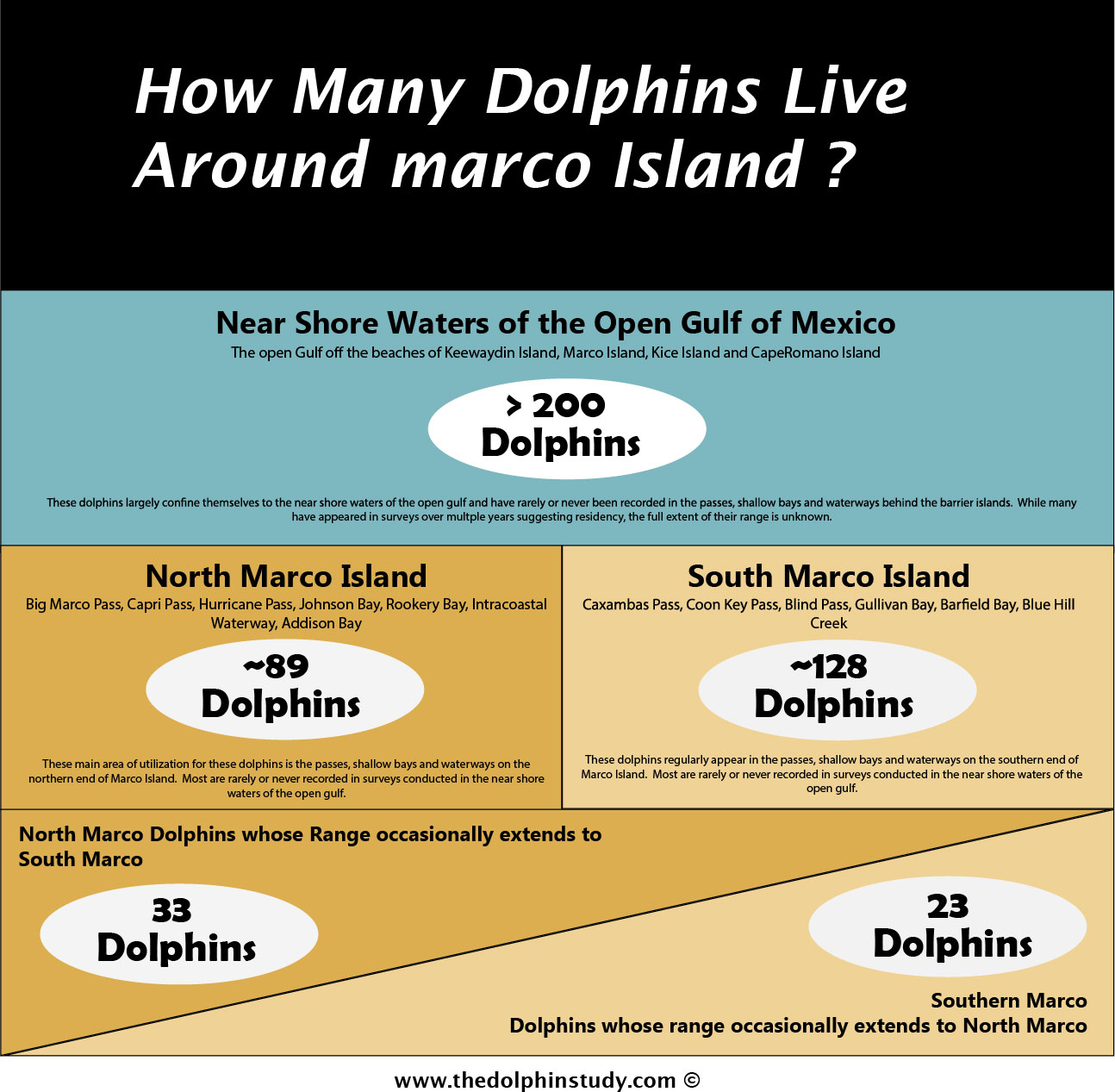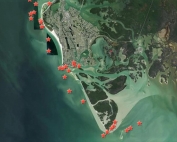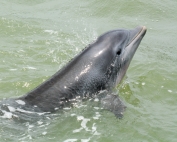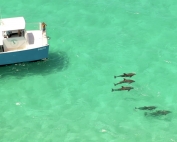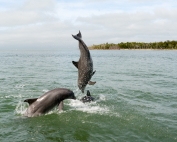How Many Dolphins Live Around Marco Island?
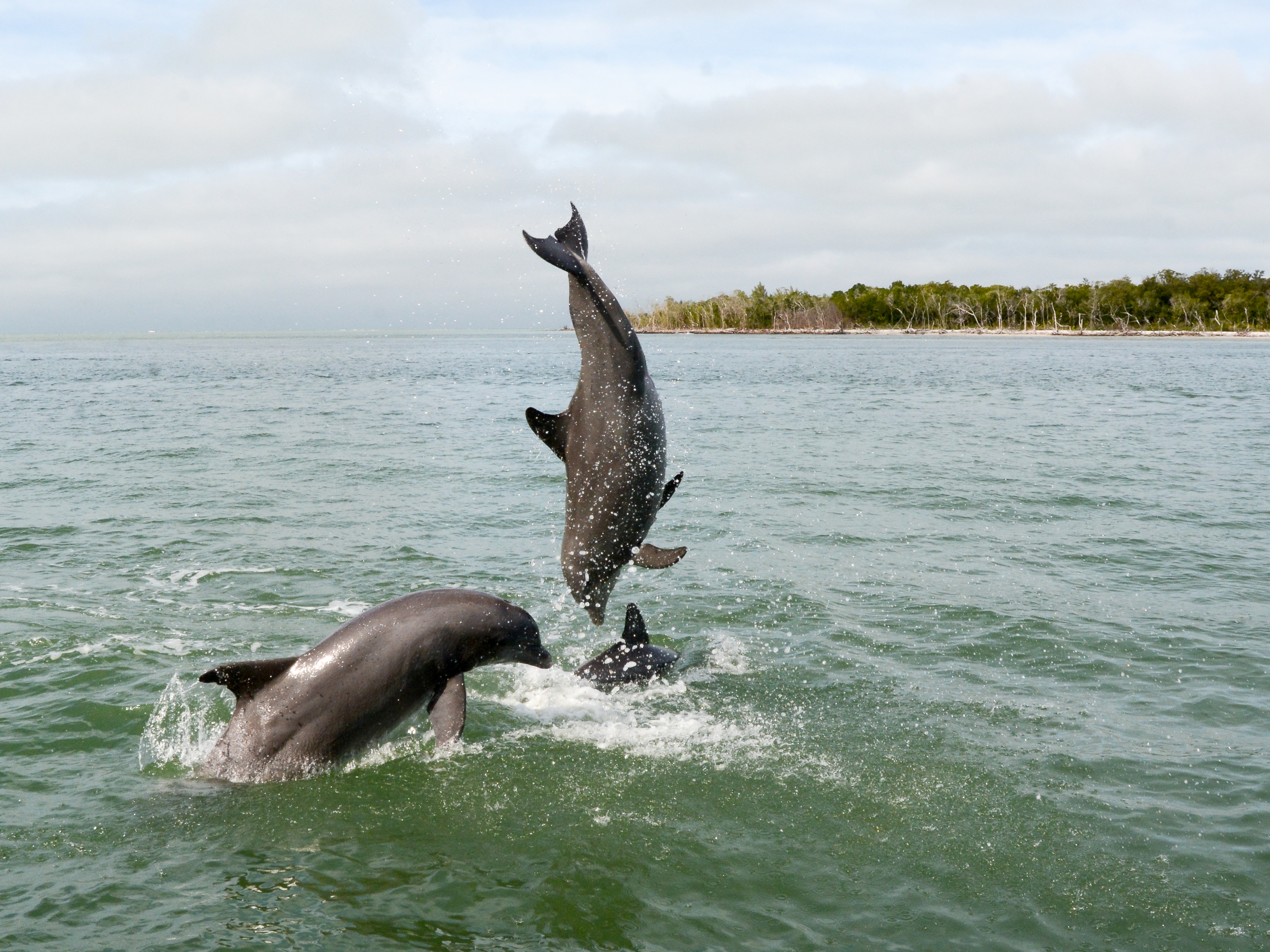
The results of 150 new boat-based surveys conducted by our partner Dolphin Research Tours between January and November 2021 have clarified the number of dolphins that live around Marco Island and provided fascinating insights into how they are distributed.
It is about 25 miles from Rookery Bay to the northern end of the 10,000 Island Wilderness preserve, an area that encompasses Marco Island and Goodland. The Dolphin Study’s photo-identification work suggests there are over 400 dolphins that use this area.
3600 + photo-identification surveys over 16 years suggest >400 dolphins use this area.
The only dolphins found in these waters are a coastal, shallow water variety of the bottlenose. They are smaller than the bottlenose dolphins that live in the deep sea and they are residential. For most, it is as they were born into a small town and never moved or travelled far.
These dolphins are divided (or rather have divided themselves) into two large groups.
- One community of over 200 dolphins keeps itself to the near shore waters of the open Gulf of Mexico. The term community here refers to members of the same species that live in the same area and interact with each other. These are the dolphins you would see if you were standing on the Marco Island beach looking out onto the Gulf or on a boat trip out to see the Dome Homes off Cape Romano.These dolphins stay out in the gulf and associate with each other. They rarely or never venture into the passes like Big Marco Pass, Caxambas Pass, Blind Pass or Coon Key Pass.
I have photographed and catalogued over 300 dolphins during surveys offshore since 2006. Over 200 dolphins were resighted or catalogued for the first time since 2019. Very few of these dolphins have ever been recorded in the backwaters.
For this reason, they don’t often mingle with a second community of dolphins that keeps to the shallow bays and channels behind the area’s barrier Islands. More work needs to be done to determine the numbers, range and community structure of this open gulf group. You can explore the sighting history of these dolphins by visiting The Dolphin Study database and selecting “Open Gulf” as the area selection.
- A second ‘backwater’ group of about 220 dolphins largely confines itself to the passes between the islands and the waters behind them – places like the intracoastal waterway between Marco and Naples, Rookery Bay, Johnson Bay, the Marco River, Caxambas Bay, Coon Key Pass etc.
Open Gulf > 200 dolphins Backwaters: ~200 dolphins
The dolphins in this second ‘backwater’ group can themselves be divided into two groups.
- The Northern Marco Island Group Thousands of surveys conducted by The Dolphin Study between 2006 and 2021 confirmed the presence of a community of about 89 long term residents centered around Big Marco Pass on the northern end of Marco Island. You can view the profiles of the individual members of this community here by selecting Marco Island from the survey area dropdown menu. Each year, however, another 10-15 dolphins would be recorded during these surveys but far less frequently and often near the southern end of the study area. This fact lead me to hypothesize that there were two overlapping backwater communities – one centered around The Big Marco pass and a second centered around the passes on the southern end of the island – Caxambas Pass, Blind Pass and Coon Key Pass. These dolphins that would occasionally appear were, I supposed, members of this southern community exploring the northern limits of their range.
- The Southern Marco Island / Goodland Group Since January 2021 my partner at Dolphin Research Tours, Robyn Standke and I have conducted 148 new surveys during our ecotours out of Goodland. The results of these surveys have both confirmed and complicated this two community hypothesis.
Marco Community ~ 87 dolphins Goodland Community ~ 106
During these surveys 550 sightings were recorded and 170 individual dolphins were identified.
107 dolphins from this group had never been recorded on the northern end of the island during any of the thousands of surveys conducted there since 2006. Of the 63 dolphins from these new ‘southern’ surveys that had previously been seen on the north end of the island, 19 of them had appeared 10 times or less in fifteen years.
In other words, the home range of 126 out of 170 dolphins we recorded on the southern end of the island during these new surveys rarely or never extends to the northern end of Marco Island.
This was strong evidence supporting the hypothesis that there are two separate but overlapping communities of ‘backwater’ dolphins around Marco – one of which centered around Big Marco Pass on the northern end of Marco and second centered around Coon Key Pass on the southern end.
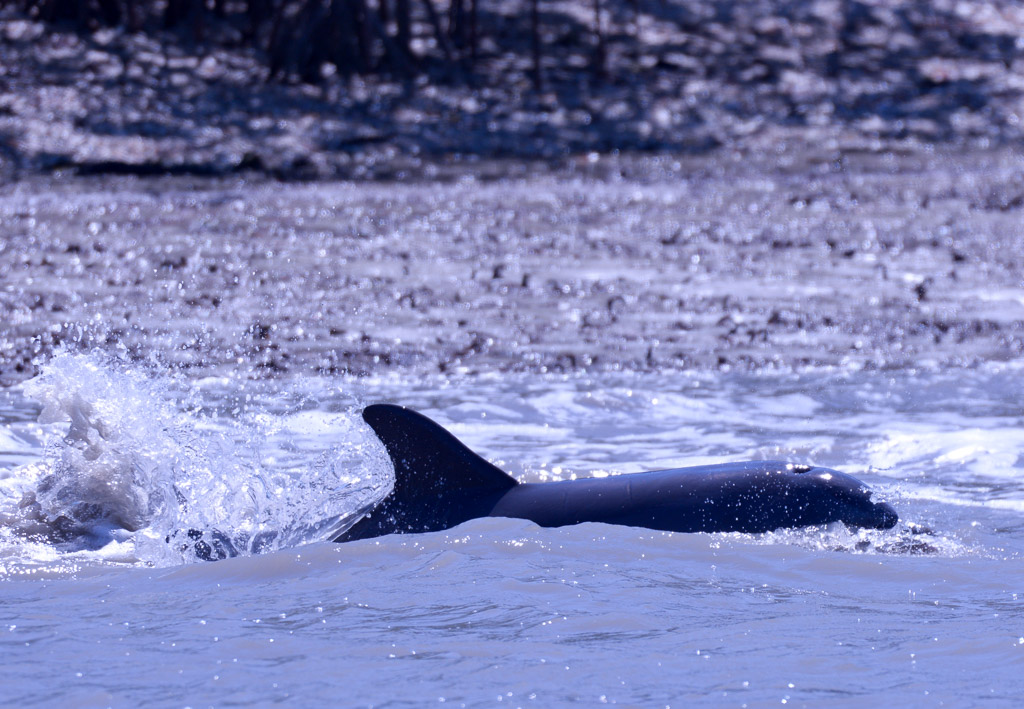
Goodland based mom Goodsix works the shallows in Coon Key Pass. She has never ventured to the northern end of the island.
Tunic and Skipper are good examples of dolphins that fit into the two community hypothesis. Skipper is a young female approaching maturity that was born on the northern end of Marco Island. Tunic is an adult female caring for a calf that lives on the southern end of the island. Their ranges rarely overlap.

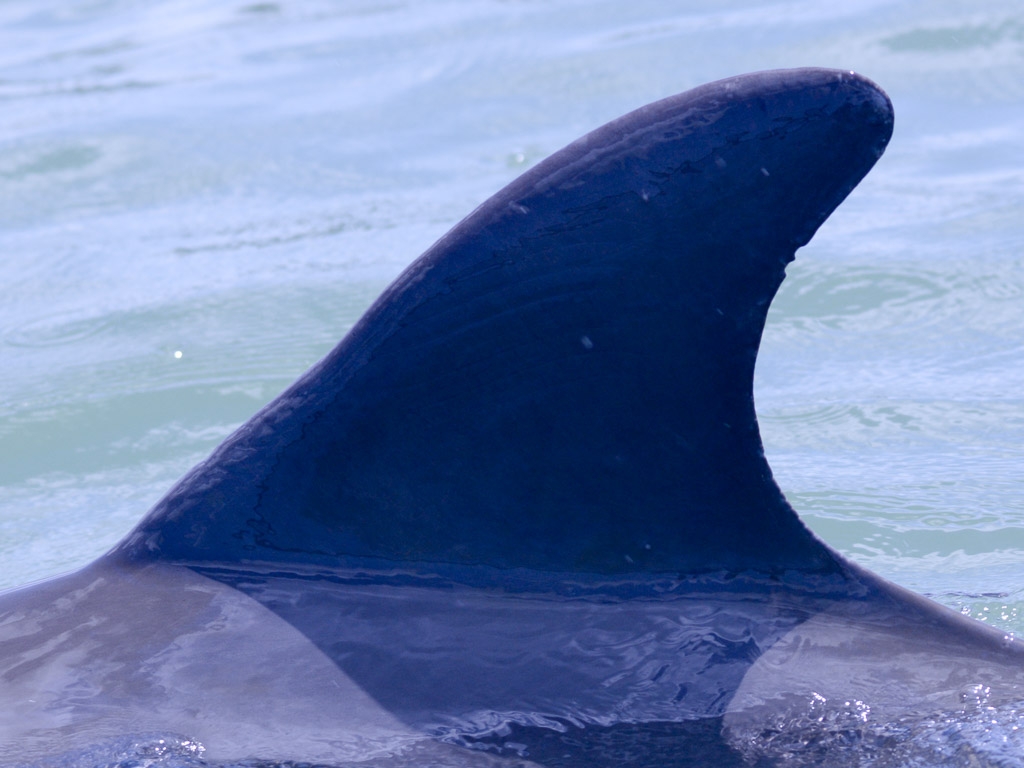
Skipper and Tunic’s dorsal fins
Black: Skipper’s sightings White: Tunic’s sightings
You can compare individual sighting histories for each of the over 200 dolphins that call the passes and shallow bays around Marco Island their home at The Dolphin Study database. Select either Marco Island (for the northern group) or Goodland (for the southern group) from the drop down selection on the dashboard. As you do this you will notice that the range of some of these dolphins do not fit this simple pattern of northern and southern residents.
A Better Way to Understand the Distribution of Dolphins Around Marco Island
The home range of most of the dolphins catalogued during surveys of the passes, bays and waterways around Marco Island inland of the open Gulf of Mexico are confined to either the northern or the southern end of the island.
Many, however, are not. As the infographic above suggests, the range of 42 dolphins include both areas at least occasionally. And for at least another 6 dolphins the distinction is meaningless – they regularly use both areas.
The sighting history of these dolphins suggest that dividing the dolphins into two communities, while helpful to a point, is more reflective of the survey approach of the researchers than the actual reality of the individual dolphins.
A close look at each dolphin’s sighting history suggests that a better way to view the distribution of dolphins is as a patchwork of overlapping individual home ranges.
Victoria, Moab and Goodsix: A patchwork of overlapping individual home ranges.
In the map above the sighting history of three female dolphins – Victoria, Moab and Goodsix are presented as colored stars. The colored outlines are home ranges suggested by these sightings. Moab’s range is a bit speculative – I am supposing that since she has never appeared north of Coon Key Pass, her full range extends south into the 10,000 Islands.
Interestingly Victoria seems to move between the various passes by way of the open gulf. Her association patterns, however, place her firmly in the backwater community. While using the gulf to move from the northern end of the island to the south, she does not appear to interact much with those dolphins that confine their range to the open gulf.
The Research Continues
By now, we have catalogued nearly every dolphin that lives in the vicinity of Marco Island – certainly those that confine themselves to the backwaters. Their profiles can be viewed in The Dolphin Study database.
Individuals and families are invited to join us aboard Dolphin Research Tours ecotours as we explore The 10,000 Island Wilderness Preserve and collect sighting data on these dolphins.
Each new sighting adds to our knowledge of Marco Island’s dolphin communities and the complex patchwork of its member’s home ranges.
How Far Do Our Local Dolphins Travel?
How Far Do the Dolphins of Naples and Marco Island Travel ? Insights on their [...]
Another Dolphin Birth: Lulu Arrives to Join The Local Community
It seems we have yet to see the end of birthing season for the dolphins [...]
The Importance of Being Skipper
The Importance of Being Skipper With the recent birth of her calf, Skipper's 2014 rescue [...]
Honest Eco in Key West: A Model for Ecotours
I Have Beheld the Future Honest Eco in Key West Sets the Standard for ethical [...]
Marco Island’s Bottlenose dolphin birthing season has begun
A local bottlenose dolphin mother and her daughter approach the birthing season together This [...]
How Many Dolphins Live Around Marco Island and How Are They Distributed
How Many Dolphins Live Around Marco Island? The results of 150 new boat-based [...]

